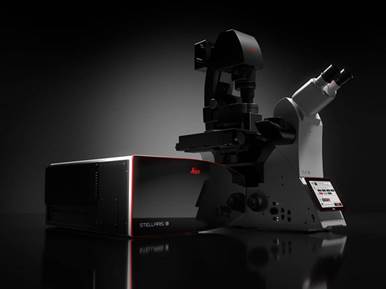News
1). Recently, Rutgers-NJMS-Imaging Core facility (http://njms.rutgers.edu/research/resources/cell_and_molecular_core/confocal_imaging_facility/index.cfm) and Dr. Dongfang Liu (Principle Investigator) have been awarded the first super-resolution τ-STED (stimulated emission depletion, 2014 Nobel-winning technology) in North American.
τ-STED is Leica's next generation in STED technology. τ-STED combines two of Leica's advanced technologies – STED nanoscopy and FALCON fast fluorescent lifetime imaging – to achieve nanoscale super-resolution with higher performance than before. In conventional STED, a STED depletion laser resembling a "donut" is precisely overlaid on a confocal excitation beam. The emission fluorescence within the STED donut is depleted, thereby leaving behind the fluorescence from the "donut hole". The emitted fluorescence from this donut hole is below the diffraction limit of light and gives the STED microscope nanoscale resolution.
Leica's FALCON fast fluorescent lifetime imaging technology measures the arrival times of individual photons with high-speed ultra-sensitive detectors and electronics. By combining Leica's FALCON and STED technologies, τ-STED can distinguish the shorter-lived photons within the STED donut from the longer-lived photons at the center of the donut.
Importantly, even low STED depletion laser powers reduce the fluorescence lifetimes within the STED depletion donut which is detectable by Leica's innovative technology. Hence, τ-STED can achieve equal or better STED resolution at lower laser powers than before. This reduction in laser power is crucial because it prolongs photostability, enables higher sampling, and facilitates longer live cell experiments. Moreover, τ-STED can utilize FALCON's ability to distinguish spectrally overlapping fluorophores based on differences in their fluorescence lifetimes. Hence, the addition of fluorescence lifetime as a new dimension in τ-STED improves STED resolution (better than 30nm), prolongs live cell STED imaging, and extends the palette of fluorophore combinations for nanoscale super-resolution microscopy.
Example applications of τ-STED include: Live cell super resolution imaging (X-Y resolution is < 30 nm); Neural synapse and immunological synapse; Vesicle trafficking and fusion pore; Cytoskeleton structure and function (actin, tubulin, vimentin, keratin etc.); Shape and size changes in mitochondria; Nephron architecture in kidneys; Nuclear pores; Virus trafficking; Changes and localization of protein complexes; Host pathogen interactions; Autophagosomes, endosomes, vesicles, and clathrin-coated vesicle biology; Structure and size of telomeres; Extracellular matrix biogenesis; Studying signaling events; Metabolism pathway; Liquid-liquid phase separation in biology, etc.

Our lab in making a splash in the scientific community!
https://www.news-medical.net/news/20200817/Targeting-SARS-CoV-2-with-off-the-shelf-CAR-NK-cells.aspx
Link to SARS-Cov-2 CAR-NK preprint: https://www.biorxiv.org/content/10.1101/2020.08.11.247320v1#:~:text=Metrics-,ABSTRACT,greatest%20global%20pandemics%20in%20history.&text=Further%2C%20CR3022%2DCAR%2DNK,with%20severe%20COVID%2D19%20disease.
Congratulations to Saiaditya Badeti for his appointment to the integrated T32 Training Program in Infection, Immunity and Inflammation!
Congratulations to Saiaditya Badeti for being 1 of 3 graduate students to be awarded the 2019 ASPIRE HIGHER scholarship provided by Ortho Dermatologics. https://www.aspirehigherscholarships.com/scholarship-2019.html
(Manuscript submitted) Minh Ma, Saiaditya Badeti, Ke Geng, Dongfang Liu (2020). "Efficacy of Targeting SARS-CoV-2 by CAR-NK Cells." BioRxiv (https://www.biorxiv.org/content/10.1101/2020.08.11.247320v1#:~:text=Metrics-,ABSTRACT,greatest%20global%20pandemics%20in%20history.&text=Further%2C%20CR3022%2DCAR%2DNK,with%20severe%20COVID%2D19%20disease.)
Our research is on News Medicals (https://www.news-medical.net/news/20200817/Targeting-SARS-CoV-2-with-off-the-shelf-CAR-NK-cells.aspx).
04/24/2019: Dongfang was invited for giving a talk at North Atlantic Microscopy Association in Rockefeller University. Invited Talk: Title ‘CAR T Immunological Synapse’.
